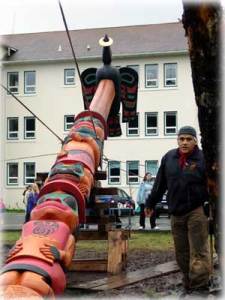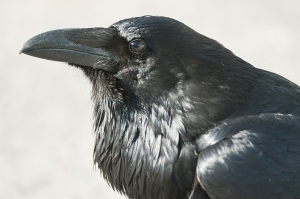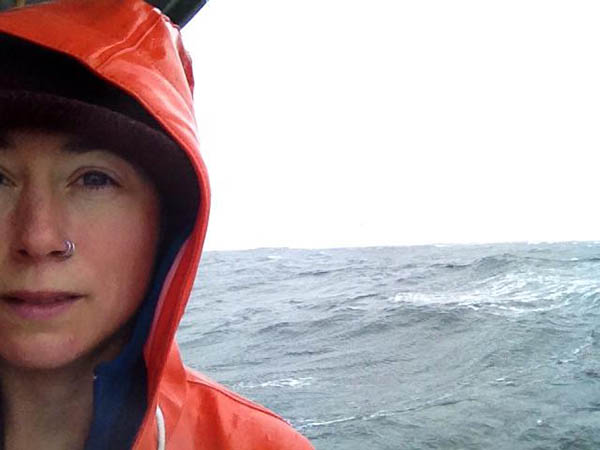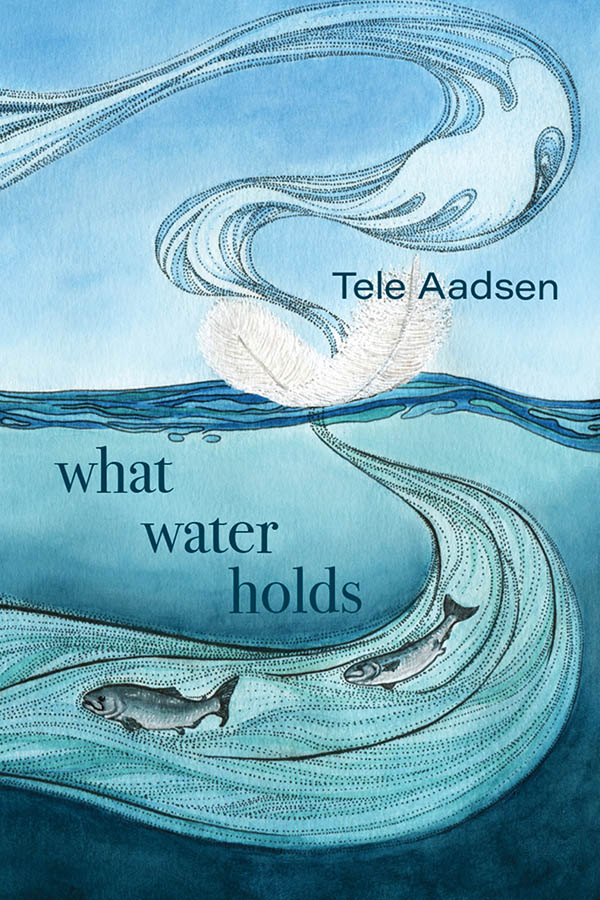On October 14, 2006, the stars lined up just right (in the alignment of bad ocean conditions) that we were tied to the dock on the day of a totem raising. The newspaper explained this “Wellbriety” totem pole, going up at the SouthEast Alaska Regional Health Consortium’s Mt. Edgecumbe campus, was honoring a process to heal the total person – physical, mental, spiritual and emotional well-being.
Just one year removed from tending to Seattle’s homeless youth, I was still seeing “my kids” nightly in my dreams. The concept of Wellbriety deeply resonated. Before I could over-think it, I’d hopped off the boat and started the 3 mile walk from the harbor to the clinic. Anxious excitement curled in my belly, I was almost running by the end.
More than 300 people had turned out for the event. A steady drizzle of Sitka sunshine fell on children, elders, families. We stood in respectful quiet – not silence, not with all those kids running around – as the ceremony began. Tlingit elders from the Raven and Eagle clans named the pole: Yei eek kwa neix. You are going to get well.
Thick rope guidelines stretched out from the 4000-pound pole. When we took our places, it was clear that the left guideline had many young men, while the one on the right largely consisted of women. An older woman in front of me called, “Can we get some more guys over here?”
I heard a little girl’s voice pipe up from somewhere unseen: “Girls can be strong, too!” Someone’s raising that kid right, I thought.
Our hands clenched, as if braced for a tug-of-war. But totem poles are stories and stories must be handled with reverence, not the teeth-gritted strain of competition. In unison, under master carver Wayne Price’s instruction, we began a slow march back.
Watching intently, an eagle perched on a nearby telephone pole, and a raven on the clinic roof. As the pole ascended, the outstretched wings of Raven, carved at the top, caught air for their first time. The eagle began keening, welcoming Raven to the sky.
Seeing Yei eek kwa neix in its entirety, I saw all of my kids’ struggles and my hopes for them. A medicine woman stood at the base, a basket of healing herbs in her hands. Above, a shaman and wolf spirit helper prepared to plunge into the darkness, retrieving those lost in addiction, torment and grief. Then, in a sprawling run free of design, the freedom to reflect and heal in the journey from darkness to light. And there at the top hovered Raven, a gleaming brass disc of the sun held in his beak, guiding us to another way.
You are going to get well.
With the pole solidly in place, people broke apart into celebratory groups. I began a slow walk back to the harbor, footsteps heavy with reflection. I thought about the gratitude and honor I felt to participate in a cultural legacy not my own, the pride of sharing a community where Native culture is not held hostage in a museum, a dusty-shelved shrine to the past, but is a living, breathing, singing, dancing present and future.
I’ve sometimes felt that “Southeastern Alaskan” is its own cultural identity. An evolution of shared connectivity that crosses racial and ethnic lines, forges bonds built of skunk cabbage springs and crowded cruise ship summers, autumns where seasonal folk sweep out as winter winds whoosh in. And I’ve second-guessed that presumption, scoffing that it’s all too easy for someone of dominant culture to imagine connection when we don’t carry the ancestral scars.
A new friend has gently corrected me. “Your culture includes the Tlingit because you are a Southeastern Alaskan. It includes living among an indigenous peoples, interacting every day. There is value in that.”
I think now about the grace in her statement, and recall the initial explanation of the pole. Roberta Kitka, Chairwoman of the sponsoring Kooteeyaa Project, said, “Wellbriety Kooteeyaa means healing, hope, unity and forgiveness for Tlingit people and anyone who is working on the healing of mind, body and spirit.”
We are going to get well.
Does this ring true for you, sweet reader? Are there places in your life where you’ve questioned your role, wondered if your presence was beneficial or baggage? What does wellness mean for you in your own life, and how do you create it?
Me, I think I’ll keep asking questions, and look to ravens for guidance.
[As with all totems, the Wellbriety pole is far more complex than a blog post could ever do justice to, particularly when written by someone engaged in such a brief sliver of the journey. A detailed description of the project, pole, and carver is here. You can also read a powerful essay about this day in Heather Lende’s book, “Take Good Care of the Garden and the Dogs: Family, Friendships and Faith in Small-Town Alaska.” My gratitude to Michael Jenkins of SEARHC for granting permission for photo usage.]






A fascinating insight, very well told. Terrific writing, Tele. And I loved the details, of the birds watching and the Raven rising, and the medicine woman’s basket of healing herbs, which all add to the wider meaning.
Thanks, Deborah! The birds’ participation was definitely one of those moments that makes you certain the universe is paying attention, and offering her approval!
What a cool post. I am curious what made you think about this now. I hope all is well.
Meryl, between this comment and your own posts, I can see the insight and “look beneath” qualities that make you such a gifted professional! No worries, all’s good. I’ve been following-from-afar the progress of Sitka’s latest totem to be going up (thus the post Totem Raising, Part 1), and that made me reflect on this experience. I appreciate your well-wishes — thank you.
What an inspiring event and your thoughtful writing drew me right into the heart of it! For me, wellness is a choice that you need to commit to — every second of every hour of every day. Great post. 🙂
Absolutely beautiful! You live — and write — so thoughtfully. Thank you for your deeply considered posts — your wonderful writing, the fab pictures.
I want to learn more!
Thanks, Tele.…
I heart reading your blog Tele. Thank you for writing! You are loved.
Aww, friends… Thank you. I’m happy that this one resonated with people.
(And Kimmie — I still have a birthday book from you, about writing, on my shelf. Thank YOU for being a longtime encourager! Hugs to you and Lil.)